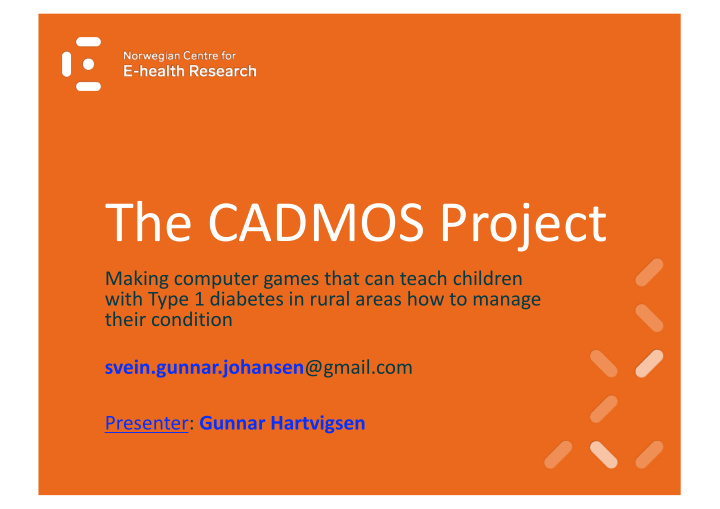



The CADMOS Project Making computer games that can teach children with Type 1 diabetes in rural areas how to manage their condition svein.gunnar.johansen @gmail.com Presenter: Gunnar Hartvigsen
Can games teach children anything useful? • Yes, but often not necessarily what the game was designed for. • Only if the game is enjoyable, and creating a good game is hard.
The problem with serious games • They are often just regular games, with some facts in them, usually presented as text or pictures.
What are we trying to accomplish? • To create an engaging and fun game, so that it will be used • Instill in the user, a mental model that allows him/her to correctly judge the right balance of food, physical activity and insulin • Give the player knowledge about the consequences of not dealing properly with diabetes.
Our solution: Iteration : Game development is more an art form than an exact • Fo or r u us s: science. As such there is really no way to make a good game other than trying something, see what does/doesn’t work and improve it accordingly. • Fo or r t th he e c ch hi il ld dr re en n: : The game is an arena where iterative learning by doing is possible without the negative effects of getting it wrong.
Iteration in practice Try new thing Fail. Succeed! Evaluate Try again FLO-1563-3DC-5N
Iteration zero: Haraldvollen 2013 - Children in the age group understand visual gauges just fine. - They show a preference for games with humanoid avatars.
Iteration 1: Game developers • Tromsø game lab: A collaboration between the University and local game developers, aimed at teaching aspiring game designers how to do a full development cycle and ship a game. • Within one semester: Thus, limiting the scope was also important.
Initial Design Mobile battle arena game where you pit teams against each other in battle for resources. -Size of clickable elements: About 1/6 screenheight -Only one clickable mode -Minimize «drop and drag»
Inspiration: Pokemon Gather/training mechanics has traditionally been popular in the age group.
Inspiration Hearthstone Proves that sparesly animated 2D graphics can be engaging, even in a post 3D era.
Avatars: Human / Robot hybrids
Iteration 2: Children in the age group We did a workshop organized by members of our local diabetes community. Our audience was 11 kids aged 12-17 and their parents.
Workshop We invited the kids to participate in the development process by: - Designing new characters - Giving feedback on what was already implemented and coming up with ideas for how to make the game better.
Results: Prototype designs for GUI elements Since the intended players helped design it, they should also be able to make use of it.
Findings - The current state of our game appeals more to boys than to girls. - According to one of the participants, it appeals even more to those who like science fiction in particular. - About 1/3 of the kids really liked being involved in the design process. 1/3 was somewhat passive, and the last third was actively disinterested. - Practically all who liked being part of the process volunteered to continue working with the game as testers after the end of the workshop.
The CADMOS Project Making computer games that can teach children with Type 1 diabetes in rural areas how to manage their condition svein.gunnar.johansen@gmail.com Qu ue es st ti io on ns s? ?
Recommend
More recommend